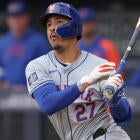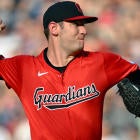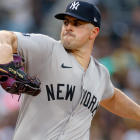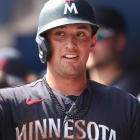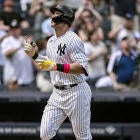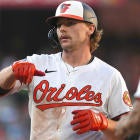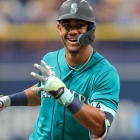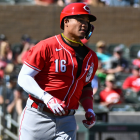If playing the game of Fantasy Baseball makes you a nerd (a line of thought I don't subscribe to, but just play along), playing in a dynasty league makes you ... something way beyond nerd. I'm not even sure there's a word for it. You not only have to know every player in the majors, but at least 100 prospects -- and then you have to track their stats over the course of the season. On top of that, playing in a dynasty league requires a constant struggle with the ages-old, "Do I play for this year, or do I play for the future?" question, while living with the paranoia that any add, drop, trade or draft pick you make could have decade-long ramifications.
It's not for the weak of heart. But it's a pretty awesome format if you have the time for it. Fantasy Baseball is a grueling exercise over a 162-game season. A dynasty league is that, multiplied by 25, cubed, divided by .001 and then multiplied by 25 again. Which makes victory so much sweeter.
What follows are some guidelines for dynasty noobs (and perhaps some fresh perspective for the dynasty pros among us).
1. Get to really know the prospects. I know that sounds obsvious and trite, but don't just take MLB.com's Top 100, print it out at work (because it's free!) and work off that. Study the list, check out Baseball America's top 10 for each team, read Scott White's list of 50 top prospects and then go to milb.com and take a look at who led the minors in home runs, steals, average, ERA last season -- all that fun stuff. Then cross-reference the players you like with Baseball Reference to get a better idea of what they've done to this point in their careers. Then take a look at the parent club and figure out where there's a crack in the lineup. Age, experience and success in the minors all play a role. As does opportunity (Aaron Hicks got his shot last year, maybe a little early, because the Minnesota center field job was open).
In most dynasty leagues, the top prospects are already owned (because we're hoarders), but there's plenty to mine as far as prospects who slip through the cracks (like Kole Calhoun or Patrick Corbin). Don't make the mistake of drafting based solely on top prospects lists. They're well-researched and solid places to start, but they are based on talent and skill, not necessarily proximity to the majors. Take some risks with players you like, and you may be rewarded halfway through the season with a callup.
2. Dig a little deeper to find some fringe prospects you like. Jeremy Jeffress is a great example of this (despite being just one major league inning away from losing his "rookie" status). He was lights out with the Blue Jays last season, with a 0.87 ERA and 12 strikeouts in 10 1/3 innings. And in 32 1/3 minor league innings in 2013, he had a 1.39 ERA and 1.11 WHIP, with 30 strikeouts. But he has a career 4.10 minor league ERA -- something didn't add up. I googled him, looked through news articles, read old updates ... and stumbled upon a gem. Jeffress had been misdiagnosed and wrongly medicated for an anxiety problem, when he actually had juvenile epilepsy. He'd been taking the wrong medication for years. In June, the Blue Jays sent him to a doctor who figured it out. The new diagnosis and prescription (along with a tweak in arm slot) changed everything. Heading into 2014, Jeffress, 25, looks like he has a real shot to relieve for Toronto, and could be converted to a starter (although the Jays have already squashed the starter idea for spring training) down the line. I will own him in most of my dynasty leagues, and can get him with a late-round pick.
Similarly, in January, I was shuffling through pages of winter league leaders and came across Mitch Lively, who has spent seven seasons in the minors and has never thrown a major league pitch. As a reliever, Lively has just one season with an ERA over 3.25, with a sub-2.15 ERA in three seasons. He was named this season's Venezuelan Winter League Pitcher of the Year, with a 1.70 ERA and 1.25 WHIP. So I went back and looked at his 2013. The Giants were stretching him out to be a starter (he hadn't started a game in his professional career before last season), and he struggled in the Pacific Coast League, with a 4.72 ERA and 1.34 WHIP. But over his last eight starts, Lively had a 2.54 ERA and 0.91 WHIP. The Giants look to have a full rotation heading into 2014, but injury (or regression) could strike at any time. Lively will probably find his way onto all of my dynasty league teams, probably as the pick right after Jeffress.
For a minor investment, I could have two very cheap starters by July 2014 (this is being very optimistic). And if Jeffress stays in the bullpen and Lively never gets a shot, there's still hope for 2015, assuming they keep up their recent success. These types of quiet minor league gambles can be huge boosts to the fortunes of a dynasty league team. I'll get my top prospects early, but these late picks could be difference-makers, especially in deeper leagues.
3. You don't have to go fully into "play for next year" or "play for this year" mode. In a 24-team Head-to-Head dynasty league last year, I lost in the championship game. But while I sent out some young talent for playoff push help, I also made a couple smaller trades that jettisoned veterans (where I had roster depth) for some younger talent. In a league this size, with eight teams making the playoffs, you can be both buyer and seller to plenty of other teams. The result is a mish-mash of keepers that have me in a great spot for this season's auction. Adam Eaton, Ryan Zimmerman, Kole Calhoun, Jon Lester and Michael Pineda (among others -- we have unlimited keepers, as long as we're under budget) are on my roster. I'm keeping them all.
While it's tidy and time-honored to have one strategy for a dynasty roster, variety is going to allow flexibility for the following season. If I traded away all my bats for young, cheap talent, I would have to wildly overspend at the auction to get veteran bats for this year. If I went all-in for a playoff push, I'd be stuck with overpriced veterans and no future talent. Keeping a nice mix, though, allows me to control my own fate at the draft, with the flexibility to take the best value picks, instead of having to scramble to pick up certain players who I would otherwise want to pass on. As a bonus, I enter 2014 already owning youth to trade to rebuilders, and veterans to trade to contenders.
4. Don't go overboard with drafting youngsters. We get it dude -- you know your prospects. But the way to really prove that is to win, not to use all your picks to show your friends that you read a few articles. It isn't so much reaching for a Francisco Lindor in the fifth round. I can understand that as part of a balanced strategy. But going Lindor in the fifth, Bubba Starling in the seventh, C.J. Edwards in the eighth, and Kyle Zimmer in the ninth is a bit much. You're passing up a chance to win in 2014 for a core of unproven -- but promising -- commodities. Look at the 2011 top prospect list, for example -- Bryce Harper and Mike Trout led off Baseball America's top 20, but Jesus Montero was third, Jeremy Hellickson was sixth, Mike Moustakas was ninth, Dustin Ackley was 12th, John Lamb was 18th and Mike Montgomery was 19th. These players could all still turn a corner, but if you were reaching for them in dynasty drafts, they aren't looking like great picks three years later. And taking all of those players probably caused the owner to pass up on veterans who could contribute that season.
I like to force myself to take prospects only in certain rounds. It's a strategy that has worked well for me the past few seasons. I'll pre-determine some rounds for prospects -- in one league last year, I targeted the first (technically the ninth after eight keepers), eighth, 10th, 16th, 21st, 22nd, and 23rd as my "prospect" rounds -- and I promised to not stray from that strategy. It resulted in me being a more focused drafter, and allowed me to worry about building a team at certain points, and building a farm at others, instead of playing ping pong with the two strategies and having to decide between a prospect and Brandon Belt as the draft clock ticked down.
5. Go look at old prospect lists for post-hype sleepers. That 2011 list may have produced some disappointment if you chased them that season, but Lamb (who hasn't been the same pitcher since Tommy John, but did make it to Triple-A last season) and Montgomery (who peaked at No. 19 on Baseball America's top prospect list but hasn't been able to get his ERA below 4.80 the last three seasons in the minors) still have some hope, and could make decent late-round gambles in dynasty leagues. All it takes is one astute pitching coach to tweak one thing in a delivery (maybe Montgomery changes where his foot lands on the rubber) and all that talent just comes rushing back.
The 2012 Top Prospect list features plenty of possible diamonds in the rough. It includes: Trevor Bauer (who worked through mechanics changes last season), Danny Hultzen (who will miss 2014 after undergoing shoulder surgery), Bubba Starling (whose progress has stalled in the minors, but has been a top prospect in the organization), Manny Banuelos (a former top prospect who could make the Yankees in relief this season), Brett Jackson (who took a major step back in 2013 but still has a good deal of talent) and Gary Brown (like Jackson, took a big step back, but was a top-40 prospect in 2012). It's likely owners of these prospects in dynasty leagues discarded them after patience wore thin. But it sometimes just takes time for talent to win out. Look at Domonic Brown last year, or even Khris Davis. Smart baseball observers deemed these players top talents, and there may be reasons (swing tweaks, arm slot issues, injury) that stalled the progress. Swooping in with late-round dynasty picks on former top prospects is a gamble worth taking, and allows you to focus your early and-mid-round endeavors on established major league players.
6. Don't propose crap trades for top prospects. Say you own Miguel Sano in your dynasty league. You've had him since 2011 and you've been waiting for this big break -- there's a very real chance he could open the 2014 season with the Twins, at which point he will hammer home runs all year. But your buzz is now worn off, because a fellow owner in your dynasty league just offered you Coco Crisp and Yovani Gallardo for him.
Lowball offers for prospects don't just get rejected -- they get the owner of the prospect legitimately angry. I know, because I've been on the receiving end of these offers. And I view anyone who has given me a lowball offer with a level of scorn and venom unmatched in my everyday life. When future deals are proposed from this other owner, not only will I reject the deal, but I will wait three days to reject it, just to play aloof and leave the trade offerer in a state of will-he-or-won't-he anxiety. If I drafted Sano two years ago, I know the kind of player he is and what he's capable of. I've watched him destroy the ball in the minors. I am genuinely excited about what he can do this year. Sano is not a mystery to me; if anything, I am more intimate with the potential of Sano than anyone outside of the Twins organization and, probably, the makers of Ballplayer: Pelotero . So when you come knocking with two players you probably weren't going to keep anyway, I take that as either an insult to my intelligence or laziness.
So don't be that guy. If you want my Sano, be prepared to give up something significant for him. Don't insult owners with offers that you would laugh away with a swift rejection. You have to play in a league with them for many more years.
7. OMG! Have fun!! The most important tip of them all!
Dynasty leagues are awesome. It's basically like getting a puppy, and then having to feed and care for it correctly in order to nurture it into a healthy dog. Except it never has to die! The more work you put into your dynasty league team, the better it will be. It's one of the more fulfilling rewards in the Fantasy universe, expanding the sample size of your Fantasy expertise from one season to several seasons.
Stay in touch with the most passionate Fantasy staff in the business by following us on Twitter @CBSFantasyBB or Nando at @NandoCBS .







